The best iPad restaurant POS systems deliver speed, mobility, and ease of use — streamlining orders, payments, and delivery.
To evaluate the best iPad restaurant POS systems for 2025, I used a scoring rubric that I built specifically for the hospitality industry. Each provider was graded across pricing, front- and back-of-house tools, payment processing, customer engagement, and emerging technologies like AI and delivery integrations. I weighed these factors to reflect what actually matters in day-to-day restaurant operations: speed, cost control, and guest experience.
After testing and comparing the top platforms on the market, Square for Restaurants earned the highest overall score in my model, thanks to its affordable free plan, intuitive interface, and broad ecosystem. Here are my top picks:
Here’s my full breakdown of the best iPad POS systems for restaurants this year, including where each one shines, where it falls short, and which type of operator will benefit most.
| My score | Minimum monthly fee | Processing rates | Offline mode | |
 | 4.00/5 | Free; $49/location | From 2.6% + 15 cents | Yes |
| Visit Square for Restaurants | ||||
 | 3.89/5 | $189 | From 2.6% + 10 cents | Yes |
| Visit Lightspeed Restaurant | ||||
 | 3.70/5 | $59* | Custom-quoted | Yes |
| Visit Lavu | ||||
 | 3.54/5 | $69 | Custom-quoted | Yes |
| Visit TouchBistro | ||||
 | 3.37/5 | $49 | From 1.99% + 25 cents | Yes |
| Visit Rezku | ||||
*According to third-party sources

Pricing: 5/5
Payments & mobility: 3.88/5
Front-of-house tools: 4.69/5
Back-of-house & office tools: 3.31/5
Consumer trends & emerging tech: 2.5/5
Expert score: 5/5
Square for Restaurants is one of the most comprehensive yet easy-to-use POS systems for small businesses on the market. It offers a few things that most restaurant iPad POS systems don’t: a free baseline subscription, no long-term contracts, and no chargeback fees.
I’ve set up multiple Square for Restaurant POS systems, and it’s always a speedy process. This software offers a seamless transition for iPad users. If you have the following iPads in your restaurant arsenal, you can simply download and use Square:
Consistent updates to kitchen management and other restaurant functions make this system much more efficient. The mobility of payments, including its card readers and intuitive mobile payment apps, makes Square fit right into restaurants that rely on iPads as their POS systems. With its robust features and accessible software, Square earned the top spot on my list.
That said, Square has limits. If you need ingredient-level inventory and advanced analytics, Lightspeed or Lavu will serve you better. And while Square works well for scaling to a few locations, once you reach enterprise-level complexity, you’ll likely need a more specialized POS.
Who should use Square for Restaurants:
Square for Restaurants is perfect for restaurant owners on a budget or with limited funds for technology. This iPad POS system is also great for those wanting quick, mobile payments or a cheap way to implement a self-service kiosk into their business.
Monthly subscription tiers:
Paid tiers have a 30-day free trial.
One-time installation fee: None. A previous version of this article cited a $600 on-site installation fee. But I couldn’t verify that in my latest research.
Processing fees:
Recent updates to Square for Restaurants: As of Spring 2025, Square introduced a major refresh under its new Square Releases initiative, delivering key hardware and software enhancements tailored to restaurants. As someone tracking platform development closely, here are the highlights worth noting:
Other standout features include its baseline POS and flexible hardware.
Restaurant features: Square revamped some back-of-house kitchen tools — add images to your POS menu for your staff to find products, add customer profiles to orders for insights into past orders, and get faster POS actions from new button mapping in its software.
Free baseline POS: Unlike the other systems on this list, Square for Restaurants offers free software for its entry-level iPad POS. You can use the iPads you own and use Square for free. With no long-term contracts, you can use the POS for as long as you need it, then move to a higher subscription tier or a whole different system if your restaurant’s needs change.
Square small business suite: Square for Restaurants POS users also gain access to the full suite of Square’s small business tools. In addition to the Square Online store, you can get its easy-to-use marketing, payroll, and appointment booking.
Flexible hardware: The Square Mount stand can convert your iPad into a freestanding or wall-mounted self-service kiosk.
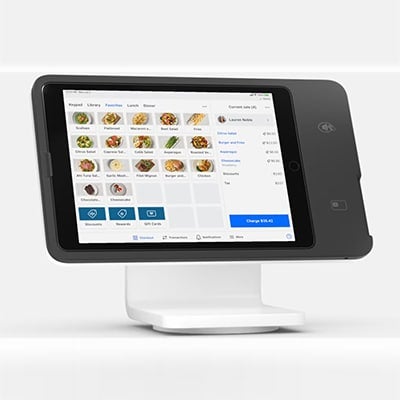

Pricing: 3.13/5
Payments & mobility: 4.38/5
Front-of-house tools: 4.19/5
Back-of-house & office tools: 4.13/5
Consumer trends & emerging tech: 3.13/5
Expert score: 4.13/5
Lightspeed Restaurant is a cloud-based, all-in-one iPad POS that consistently ranks among the best POS systems for restaurants. Its recent price hike pushed it down to second place in my evaluation, but the core product remains one of the strongest I’ve tested.
In practice, Lightspeed feels polished and powerful, especially for restaurants where food cost and loyalty programs drive profitability. The analytics suite stood out in my testing — I could track margins in real time and identify which dishes or staff shifts delivered the best results.
Against my rubric, Lightspeed excelled in back-of-house tools and emerging tech. Its ingredient-level costing, real-time margin tracking, and integrated loyalty features go deeper than almost any other iPad POS I’ve used.
Who should use Lightspeed Restaurant:
Lightspeed Restaurant is perfect for operators who want in-depth analytics and robust tools to accompany their iPad POS systems. Additionally, this POS system is friendly to integrations like QuickBooks, making it easier for operators with existing tertiary tech to blend their different tools.
Monthly subscription plans*:
*Prices are lower for users who pay fees annually and enroll in Lightspeed Payments.
One-time installation fee: None
Payment processing: Lightspeed Payments starts at 2.6% + 10 cents for in-person payments
Recent 2025 updates to Lightspeed Restaurant: Here’s what has been added to Lightspeed Restaurant in 2025:
Other standout features include its order-ahead and customer self-ordering capabilities.
Order ahead: You design your order-ahead online ordering site from the Lightspeed Restaurant back-office dashboard. The site fully integrates with your POS, so online orders appear automatically in your order stream.
You can accept orders for in-house pickup, curbside pickup, or delivery. You can rely on third-party delivery drivers or use an in-house team (though you’ll need an integration to manage delivery routes).
Customer self-ordering tools: Lightspeed Restaurant users have several options for customer self-ordering. You can use QR codes to receive orders and payments from customers’ smartphones.
Quick-service mode: Lightspeed Restaurant includes a quick-service ordering mode for bars and counter-service restaurants. This mode keeps ordering and payment buttons on a single screen for efficient ordering.
Advanced reporting: Lightspeed’s reporting features surpass the other options on this list. Customer history syncs with Lightspeed Payments, offering spending history even if you use different cards. Lightspeed’s reporting tools offer other key features, such as tracking top-performing staff, customer return rate, and menu item revenue analysis.
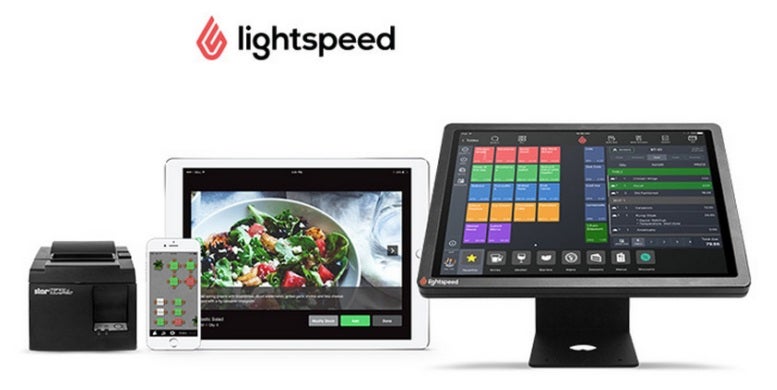

Pricing: 2.5/5
Payments & mobility: 4.75/5
Front-of-house tools: 4.69/5
Back-of-house & office tools: 3.75/5
Consumer trends & emerging tech: 2.5/5
Expert score: 3.13/5
Lavu is a self-installable, iPad-based POS app that’s easy to set up and straightforward to run. That makes it a good fit for a range of restaurant types, from cafes to full-service operations, without the need for outside technicians.
Customer management is a clear strength. It allows you to create detailed customer profiles that track key information for each customer. Its loyalty tools build on this, offering customers birthday deals and other recommendations before issuing a final check.
The backend, however, felt dated, with clunky menus and a bill-splitting flow that took longer than competitors. Pricing is also quote-only, which adds friction compared to Square’s transparent tiers.
Who should use Lavu:
Lavu’s iPad POS system is great for businesses that want to focus on customer management and creating loyalty with their customer base. Robust customer tools make it a highlight for businesses that rely on customer loyalty and positive online customer reviews.
Customer management: Lavu creates detailed customer profiles that track contact information, birthdays, and how customers learned about your restaurant.
You can add custom fields to track additional information and set your Lavu POS to prompt servers to add a customer before beginning a check to ensure you never miss the chance to track a transaction. Customer profiles also sync with Lavu’s built-in loyalty tools.
Dual pricing: Lavu offers dual pricing, setting pricing lower for cash payments and higher for credit card payments, offering a way to cover processing fees for your business, similar to what Rezku offers.
Offline payment processing: While some of its offline features may not be the best, Lavu does offer a Payment Card Industry (PCI) standard payment processor that will accept payments even if the Wi-Fi goes out.
Efficient customer-facing menus: You can create time-restricted menus, such as a happy hour menu, for your customers to experience at different times throughout service. For pizzerias, it has a pizza customization module, which extends to online delivery.
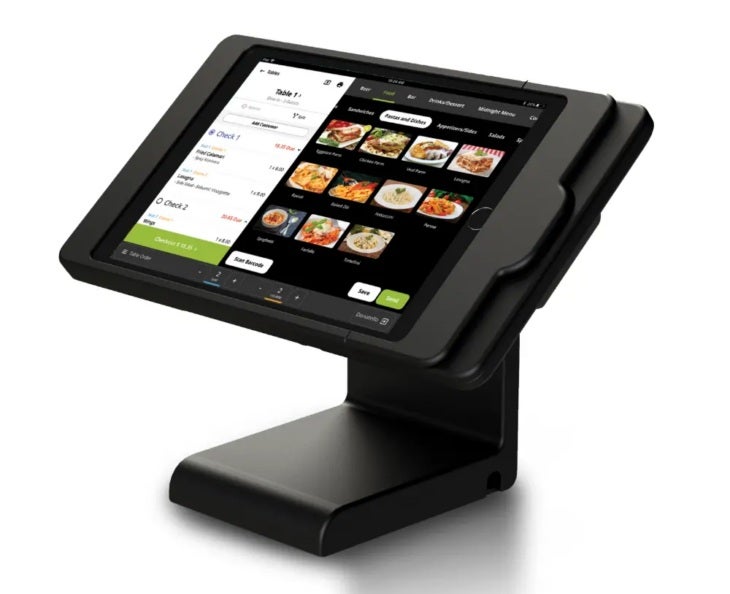

Pricing: 3.13/5
Payments & mobility: 3.25/5
Front-of-house tools: 4.25/5
Back-of-house & office tools: 4.25/5
Consumer trends & emerging tech: 1.88/5
Expert score: 4.38/5
TouchBistro is a native iPad POS designed specifically for the food and beverage industry. It includes a food ordering system and other great features for all types of restaurants.
What makes it especially good for cafes, pubs, and breweries is its quick-order screens and the ability to organize tabs efficiently. These capabilities and affordable hardware options make it an accessible system for small yet busy food businesses.
TouchBistro doesn’t offer a free plan, but it is still very affordable with its $69 per month offering. Its lack of a native kiosk mode dropped its overall score, but it still offers plenty of solid features.
Who should use TouchBistro:
TouchBistro’s new customer-facing screen makes this POS ideal for marketing new items while ensuring order accuracy and speed in quicker food business settings. Cafes, food trucks, breweries, and QSR business types should all look into TouchBistro.
Customer-facing screens: TouchBistro offers the option to have a second iPad attached to your iPad terminal, offering customers a screen to see orders in real time.
Two screens can allow for better accuracy, especially for cafes that have drinks with many modification options. These screens can be used to market new menu items or current deals when not in use.
Integrated online ordering: For an additional $50 per month, TouchBistro users can add integrated online ordering. You can accept online orders for pickup, curbside pickup, or delivery. Like Square for Restaurants, TouchBistro includes map-based delivery tools to help you manage a team of on-staff drivers.
If you prefer to use one of the best food delivery software solutions, you can integrate it into your TouchBistro POS via connector apps like Deliverect or Ordermark.
Flexible hardware: TouchBistro includes restaurant technology like customer-facing displays, KDS screens, and tableside ordering tablets. You can manage all of these peripherals from your TouchBistro management dashboard. TouchBistro offers software for these tools with transparent monthly pricing.
Bar features: Like Lightspeed Restaurant, TouchBistro offers a condensed quick-order screen to help your bartenders speed through orders. With TouchBistro, you can pre-authorize bar tabs with a card swipe, customize tab names, and quickly transfer bar tabs to tables.
Ease of use: TouchBistro’s user interface resembles an iPhone more than any other system on this list. This design makes TouchBistro easy to learn for both you and your staff. Anyone who has used an iPhone can navigate TouchBistro in no time. Many user reviews mention how quickly new staff learn the system.
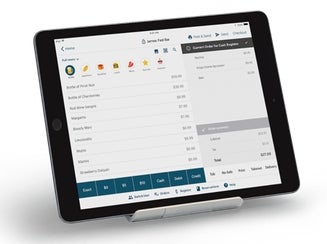

Pricing: 2.81/5
Payments & mobility: 3.25/5
Front-of-house tools: 4.19/5
Back-of-house & office tools: 3.5/5
Consumer trends & emerging tech: 2.5/5
Expert score: 3.88/5
Rezku is an iPad POS built specifically for restaurants and bars, and it stands out by including nearly everything an independent operator might need in its baseline system. Gift cards, online ordering, marketing, reservations, and even delivery management come bundled into the platform — features that competitors often reserve for higher-tier plans.
Pricing is another strength. Rezku recently dropped its mid-tier Growth plan from $99 to $49 per month, making it one of the most affordable options for full-featured restaurant POS software. The trade-off is that the free plan now only includes one terminal, but the lower cost of entry on the Growth tier offsets that for most single-site operators.
In testing, I found Rezku intuitive for order entry. Modifiers were easy to apply, and the KDS integration worked smoothly. What impressed me most was the built-in delivery management: I could assign drivers, track deliveries, and manage tickets without needing a separate app. That’s something you don’t get natively with Square or TouchBistro.
Rezku’s limitation is scalability. Larger restaurants with multiple locations or complex analytics needs will find Lightspeed or Square better suited. But for independents who want strong delivery tools and a feature-rich system at a lower monthly cost, Rezku delivers excellent value.
Who should use Rezku:
Rezku is great for users looking for key POS functionality for an iPad at an affordable rate. Even Rezku’s higher-priced tier is affordable and offers users many different tools.
Monthly subscription tiers*:
*One terminal is included with the subscription; extra terminals require additional fees.
Processing fees: From 1.99% + 25 cents in the Growth tier
One-time installation fee: $0
Free baseline POS: Rezku has moved to a free baseline POS tier. This tier gives you free access to all its great features, furthering the quality and resources available to smaller restaurants. Note that for the Essential (free) subscription, the payment processing fee is higher at 3.09% + 15 cents for card-present transactions.
Comprehensive all-in-one POS: Rezku’s baseline POS includes an exhaustive list of software tools. You get ingredient-level inventory tracking with low stock alerts, online ordering with delivery management, points or dollar-based loyalty and rewards, gift cards, and more.
Cash discount setting: Rezku includes a setting that automatically calculates a discount for customers who pay in cash. The discount amount will be the same as your credit card processing fees. So, if customers pay with a credit or debit card, your processing fees are covered.
This workaround can sidestep laws in 10 states prohibiting small businesses from passing card processing fees onto customers. If the prospect of credit card processing fees has kept you from getting a POS, Rezku might be your perfect fit.
Employee management: Rezku’s employee management tools include an integrated time card system, clock in/out, photo clock-in to prevent buddy punching, and more. The reports include labor cost analysis, payroll exports, and shift management applications. It even calculates your payroll based on employee position, pay rate, and hours.
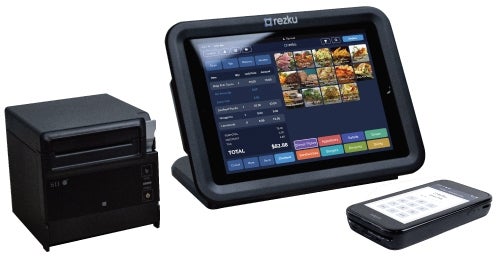
Choosing an iPad POS for your restaurant is like selecting any restaurant software. The process is straightforward, but it’s important to give yourself enough time to consider several options before making a final selection. iPad POS software offers specific advantages, so it’s important to ensure they align with your business needs.
Read also: POS System Costs, Types & Benefits: A Guide for Independent Restaurant Owners
Before you can select the best iPad POS for your restaurant, you need to know what you’re looking for. An iPad restaurant POS system can perform just about any restaurant function you can think of, including menu, check, table, and tab management.
Some iPad restaurant POS systems will also support reservations, self-service kiosks, menu displays, ingredient-level inventory tracking, delivery management, and cash discounting. So, the sky might be the limit.
List everything you want to run your restaurant. And don’t forget about your staff’s needs. Your employees will use this system every day, so if there is a feature (like KDS screens or tip pool management) that will make their lives easier, add it to your list.
You can find iPad POS systems for restaurants at virtually every price point, from $0 per month to more than $100 per tablet. Most iPad POS systems require monthly software fees. You’ll also need to budget for hardware. Even if you have your iPads already, you may need printers, card readers, Wi-Fi boosters, and routers.
Finally, you’ll need to determine what payment processing fees you can afford. If your menu is priced low, you may prefer a POS that supports cash discounting or surcharging so you can pass credit card fees on to your customers (where legally permitted).
Look at your sales and profitability and determine how much you can afford per month. There is no use looking at a system you ultimately can’t afford. So, know your limits before you test-drive any systems.
Every restaurant iPad POS offers a demo, during which a live agent walks you through the system on a video call. Some (like Square) also offer a free trial. Search for systems that fit your budget, then schedule demos or free trials with three to five POS providers.
Most POS brands ask for your restaurant style and sometimes your location before scheduling a demo to ensure they show you the most relevant features. They’ll also want an email address and phone number.
Have your list of desired features on hand for any demo you attend. It’s also useful to write down any questions you might have about granular functionality or additional costs. Most demos take around 30 minutes, but I’ve seen them go 45 minutes to an hour if I have a lot of questions.
You might really love the first system you demo. But I always like to look at least two more. By considering multiple systems, you can feel more confident in your final choice.
After getting several demos or free trials, compare each system to your list of must-have features and your budget. The comparison should be based on features specific to your business.
For example, one POS system may offer more total features, while another has stronger niche features for your specific business type. Comparing in relation to your business needs is the best way to decide which iPad POS is best for you.
The best iPad restaurant POS system for your restaurant is the one that has most of your desired features at a price you can afford. The best POS may be different for different restaurant types. Get input from your managers and chefs to help you make your selection. Then, follow up with the brands you demoed to let them know you’ve made a decision.
Following up is an important step because the sales representatives from the POS brands you contacted will continue following up with you via phone or email until you either sign up or tell them you’ve selected a different POS provider. The constant messages can be pretty annoying, so save yourself the back and forth by letting the sales teams know that you’ve made your choice.
It’s OK if you choose a different system than neighboring restaurants, or if you take a risk and try a new system you’ve never heard of before. One of the bonuses of an iPad POS is that most of these systems’ contracts only last a year or less, so you have some flexibility if your initial POS provider proves to be lackluster.
With iPad POS systems, installation is frequently as simple as creating an account with the POS provider’s sales team, then downloading an app from the Apple App Store and installing the app on the hardware you already own.
However, some iPad restaurant POS systems only operate on iPads purchased directly from the brand itself. In that case, there will be some lead time waiting for your hardware to ship. Though typically purchased hardware will come with at least some pre-configuration already done for you.
Once you’ve created your POS account and received your hardware, most iPad restaurant POS companies provide you with remote installation assistance. A customer support representative will walk you through connecting receipt printers, kitchen printers, cash drawers, and other hardware.
The rep will also usually help install your card readers and ensure your payment process works. Once you and your rep configure your hardware, you can enter your menu and start ringing in orders.
Evaluating iPad POS systems is a unique process due to the specific nature of their use. Mobile, efficient, and customer-friendly, iPads offer a unique and great way to take orders and manage restaurant functions in almost all food businesses.
Editorial note (September 2025 update): I revised this rubric to better reflect how restaurants use iPad POS systems today. In addition to core pricing, payment, and operations criteria, I added a new category called consumer trends and emerging tech that includes omnichannel and delivery, along with AI and automation.
This reflects the growing importance of unified order management across dine-in, takeout, and delivery, as well as predictive tools that help restaurants optimize menus, reduce waste, and personalize customer experiences. The updated framework ensures the scoring mirrors both current operator needs and the technologies shaping restaurant POS in 2025.
To identify the best iPad POS systems for restaurants, I graded each option against seven categories. The scoring weights highlight where operators should place the most value in today’s market.
Yes. Most modern POS software providers offer iPad apps that let restaurants take orders, process payments, and manage operations directly from the tablet. You may need additional hardware such as a stand, card reader, printer, or cash drawer, depending on your setup.
iPads are portable, intuitive for staff, and cost less than traditional touchscreen terminals. Restaurants use them for tableside ordering, mobile payments, kitchen display integration, and syncing online orders with in-house operations.
Most iPad POS systems for restaurants cost $49 to $189 per month, per terminal. Lower-tier options like Rezku or Lavu start under $60, while more advanced platforms such as Lightspeed or TouchBistro run higher. In addition to subscriptions, expect to pay 2.5%–2.9% + 10 cents per transaction in processing fees and purchase iPads or peripherals separately.
The most affordable option is Square for Restaurants, starting at $49 per month. Lavu follows at $59. Square for Restaurants also has a free plan, but most restaurants upgrade to the paid tier to unlock table mapping, advanced reporting, and seat management.
Rezku is a strong choice thanks to its built-in delivery management and integrations with popular platforms. Square for Restaurants and Lightspeed Restaurant also sync with services like DoorDash and Uber Eats, making it easier to manage takeout and delivery orders alongside dine-in operations.
Square for Restaurants is often the top pick for QSRs. It offers fast checkout, mobile payment acceptance, and menu customization at an affordable price. Its free plan makes it accessible for very small operators, while the paid plan adds advanced tools for growing businesses.
Choosing the right iPad POS system comes down to matching features with your restaurant’s needs. If you’re looking for affordability and ease of use, Square for Restaurants remains a go-to option. Lightspeed is the better fit if analytics and reporting drive your decisions, while TouchBistro excels at tableside service. Rezku offers strong value with built-in delivery tools, and Lavu stands out for its online ordering and customer engagement features.
What matters most is balancing cost, payment flexibility, offline reliability, and the front- and back-of-house tools that simplify daily operations. With the right iPad POS in place, restaurants can improve speed of service, cut waste, and meet guests where they are, whether that’s at the table, on the go, or online.
Agatha Aviso is a seasoned expert in retail, eCommerce, and order fulfillment, with a specialization in payments, POS systems, and eCommerce software. She has collaborated with startups and service-based entrepreneurs on content strategy, offering digital marketing expertise and guiding small business owners in launching their online storefronts. Beyond consulting, Agatha applies her knowledge firsthand—building her own website as well as ecommerce sites for the platforms she reviews.
Property of TechnologyAdvice. © 2025 TechnologyAdvice. All Rights Reserved
Advertiser Disclosure: Some of the products that appear on this site are from companies from which TechnologyAdvice receives compensation. This compensation may impact how and where products appear on this site including, for example, the order in which they appear. TechnologyAdvice does not include all companies or all types of products available in the marketplace.